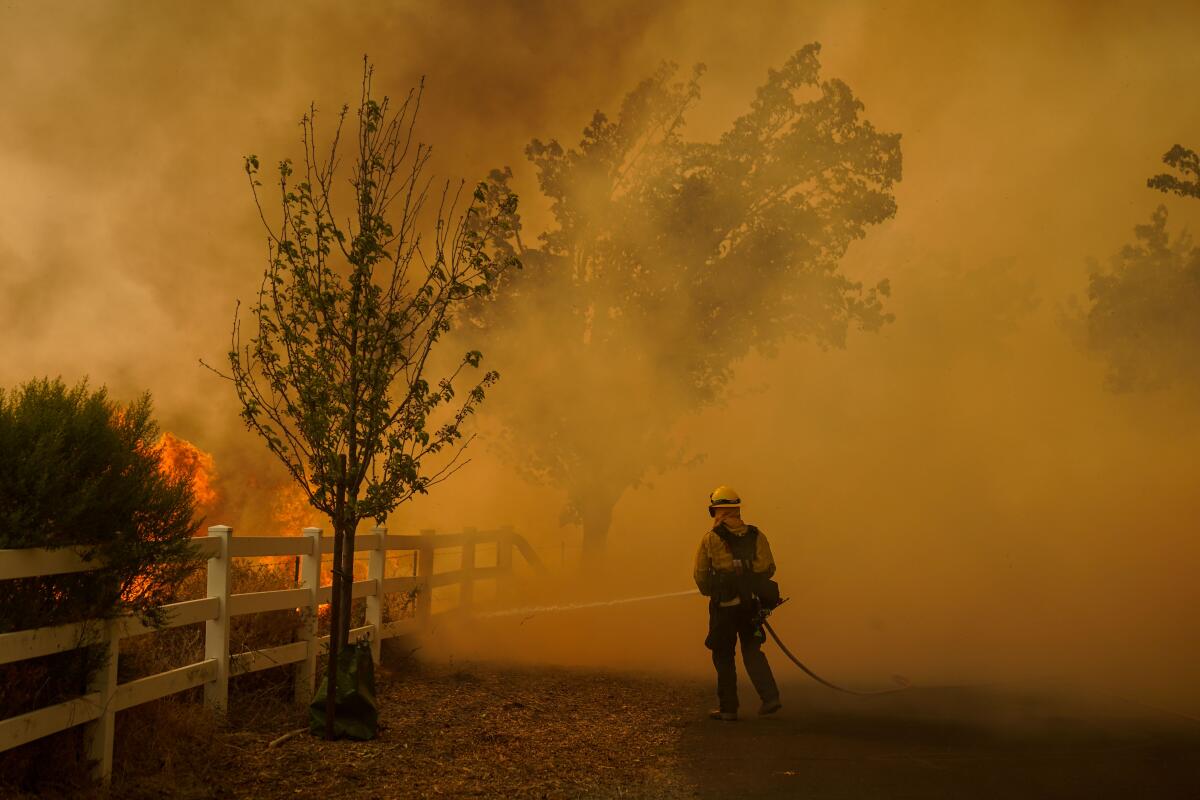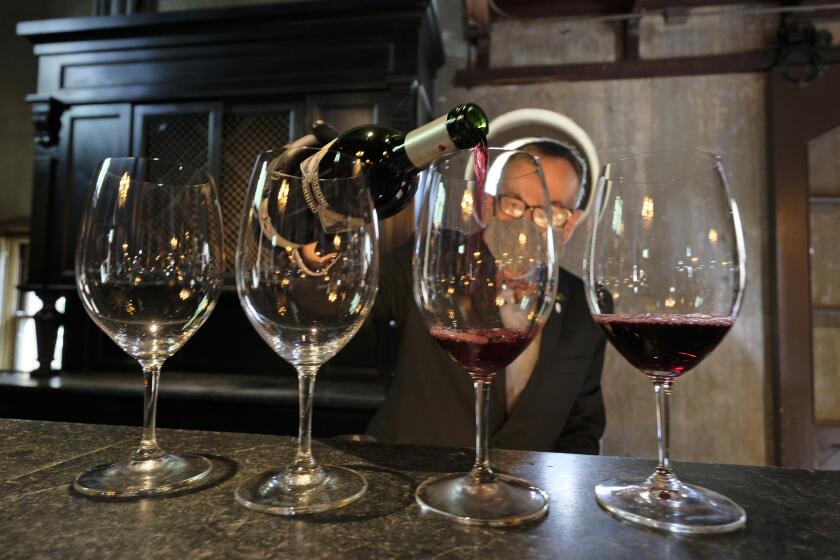Op-Ed: Pouring wine as Napa burns: Between the fires and the pandemic, who will visit when we reopen?

- Share via
It’s 112 degrees. I’m blinking sweat out of my eyes as I try to breathe through my mask and talk to my guests about the 2017 Cabernet Sauvignon in their glasses. I’m bothered that the heat and breathless air don’t seem to trouble them, but I continue on, talking about the distinguishing factors of that vintage: severe heat and wildfires.
With COVID-19, wine tastings in Napa Valley can happen only outside. During the unprecedented heat spell in early August, I was advised to stay hydrated, take breaks, and watch for signs for heat exhaustion and heatstroke in both myself and our guests. Each day my co-workers and I carried on, pouring wine and pretending that we were superhumans who weren’t affected by the weather.
Besides our safety, the only thing that mattered was guest satisfaction. Even in a crisis, wealthy tourists stay wealthy. They keep us in business, and in return, we don’t bring the mood down.
Under the beating sun, I tell my guests: “This year looks like a great vintage. We just hope for a drama-free harvest.”
Three days later, on the morning of our commencement picking of Sauvignon Blanc, the Hennessey fire started on the east side of St. Helena, just four miles from the winery. Since then it has evolved into the LNU Lightning Fire Complex, burning more than 350,000 acres and destroying 800 structures, including my co-worker’s home in the Berryessa Highlands. As I write this, the fire is still burning, smoke taints the air and an eerie orange glow streams through my window.
I came to Napa Valley a year and a half ago to pursue my passion for wine on the pretext of the California Dream. My job, as a wine educator for a high-end winery, should be one of the best around. But I might have moved here at the worst time in recent history.
The last few years have been plagued with unthinkable heat waves and the apocalyptic wildfires that have ravaged the local wine industry: smoke-tainted grapes, evacuations during harvest, rolling blackouts and crippled tourism. Napa Valley is experiencing the reality of climate change: It is hotter and drier every year. What didn’t burn this year will burn next year, and so on.
If that wasn’t bad enough, COVID-19 has dramatically strained the wine industry. When wineries in Napa Valley reopened in mid-June after being closed for three months, many hospitality staff members did not return to work because they were older (and more susceptible to the virus) or because they were permanently laid off. For many small wineries, tasting room sales and wine club sign-ups are their only form of business. But even the larger ones that sell wine to restaurants have seen their sales come to a screeching halt. Online sales are the saving grace for many brands, but they’re not always enough to keep the business afloat — especially when the latest fires are causing tourism to decline again.
Sonoma County wineries are reopening to an altered landscape
It’s hard to sell wine when the weather forecast is smoky, it’s raining ash and the global pandemic keeps people home.
The people who live here are simply exhausted. We are tired of the anxiety, the packing and unpacking, and the fear of losing our loved ones and our homes. Besides, the region is pricing out its workers. Most people who work at wineries live far from them in less expensive towns such as Vacaville, Fairfield, Windsor, Healdsburg and Santa Rosa.
Yet those locations have suffered the most from wildfires. I asked my co-workers why anyone would choose to live on the outskirts of the valley where rolling dry grasslands are prone to fires. It seemed obvious that those homes are risky investments considering the danger. But I was repeatedly told the same thing: It wasn’t like this until a few years ago.
Each year we wait patiently for the annual grape harvest, which starts in mid-August. Normally, this is the most exciting time to be in wine country — there are endless parties, extravagant dinners, grape-stomping photo shoots and the promise of a great vintage. But things are different now. Napa Valley is deflated as many wineries question how badly the grapes have been tainted by smoke, and if it’s possible to use the fruit at all. Vineyard workers are risking their health — due to unhealthful air quality and a pandemic — because they can’t afford not to.
The winery I work for has been closed for a week because of bad air quality and its location in an evacuation zone. When we reopen, who will want to visit?
Olivia L. Eckerson is a wine educator in Napa Valley.
More to Read
A cure for the common opinion
Get thought-provoking perspectives with our weekly newsletter.
You may occasionally receive promotional content from the Los Angeles Times.










